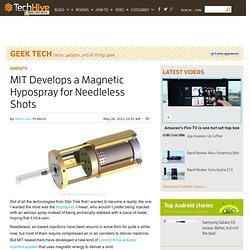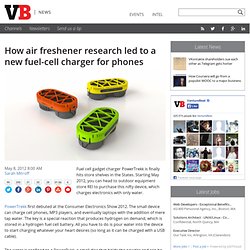

Keyboard bubbles up from touchscreen when typing, deflates when done. Keyboard bubbles up from touchscreen when typing, deflates when done Novel technology will provide tablet and smartphone users with amazing new way to use a physical keyboard Now you see it, now you don’t.

Tactus Technology has made its first public demonstration of an exciting new concept technology: the Tactile Layer component. Tactus’s Tactile Layer technology provides owners of touchscreen devices with the ability to use a physical keyboard. The technology provides owners with an appearing and disappearing haptic user interface for their smartphone or tablet device. It was presented for the first time at this week’s Society for Information Display (SID) show, where it was presented in the I-Zone, an area reserved for highlighting the newest and most innovative display technologies. How are they doing this? The company’s Tactile Layer technology is the world’s first deformable tactile surface. Tactus Technology’s Tactile Layer could be applied to remote controls.
Video Outlook. Un-cloud your files in cement! 'Dead Drops' is an anonymous, offline, peer to peer file-sharing network in public space. MIT Develops a Magnetic Hypospray for Needleless Shots. Out of all the technologies from Star Trek that I wanted to become a reality, the one I wanted the most was the Hypospray.

I mean, who wouldn’t prefer being injected with an aerosol spray instead of being archaically stabbed with a piece of metal, hoping that it hit a vein. Needleless, air-based injections have been around in some form for quite a while now, but most of them require compressed air or air canisters to deliver medicine. But MIT researchers have developed a new kind of Lorentz-force actuator injection system that uses magnetic energy to deliver a shot. The mechanics behind the actuator involve a powerful magnet surrounded by a coil of wire that’s also attached to a piston inside the drug ampoule (usually a small vial container).
When an electrical current is applied, the magnetic field pushes the piston forward, causing the drug to eject forward as a jet of liquid. [MIT via Gizmag and Gizmodo] Like this? Found: Imagine the Future of Watches. High Speed Travel Tubes Can Take You From NY to Beijing In 2 Hours - Elite Daily. The Evacuated Tube Transport (ETT) system would take passengers from New York to Beijing in just two hours.

Advocates of Evacuated Tube Transport (ETT) claim it is silent, cheaper than planes, trains, or cars and faster than jets. How it would work: put a superconducting maglev train in evacuated tubes, then accelerate using linear electric motors until the design velocity is attained. Passive superconductors allow the capsules to float in the tube, while eddy currents induced in conducting materials drive the capsules. Efficiency of such a system would be high, as the electric energy required to accelerate a capsule could largely be recaptured as it slows. The train capsules will be inserted and taken out of the tubes at “airlock stations at stations along the routes.”
Capsules can be made large enough for one person to travel or a large bus; however, the ideal capsule size will be the same as a car and carry four to six passengers. Elite. Fuel cell charger. Fuel cell gadget charger PowerTrekk is finally hits store shelves in the States.

Starting May 2012, you can head to outdoor equipment store REI to purchase this nifty device, which charges electronics with only water. PowerTrekk first debuted at the Consumer Electronics Show 2012. The small device can charge cell phones, MP3 players, and eventually laptops with the addition of mere tap water. The key is a special reaction that produces hydrogen on demand, which is stored in a hydrogen fuel cell battery. All you have to do is pour water into the device to start charging whatever your heart desires (so long as it can be charged with a USB cable).
Atomic-scale magnetic memory. The world's smallest bit Scientists from IBM Research have been investigating and controlling matter on an atomic scale for decades.

So, naturally, their latest quest would involve greatly decreasing the storage capacity needed for one bit of data, which on today's computers stands at about 1 million atoms. They set out to develop the ultimate memory chips of the future. Starting at the very beginning of density—single atoms—they created the world’s smallest magnetic memory bit and answered the question of how many atoms it takes to reliably store one bit of magnetic information at a low temperature: 12. By studying the behavior of atoms, researchers can identify crucial factors for building smaller, faster and more energy-efficient devices for business and consumers. A history of innovation As one of the last remaining industrial labs, IBM continues to emphasize fundamental science and investment in R&D.